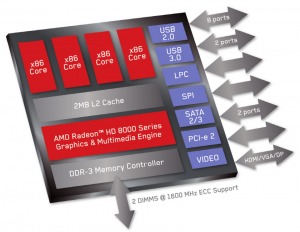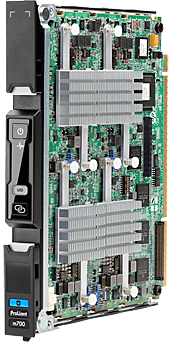To-date I have not been too excited about HP’s Moonshot system, I’ve been far more interested in AMD’s Seamicro. However HP has now launched a Moonshot based solution that does look very innovative and interesting.
HP Moonshot: VDI Edition (otherwise known as HP ConvergedSystem 100 for hosted desktops) takes advantage of (semi ironically enough) AMD APUs which combine CPU+GPU in a single chip and allows you to host up to 180 users in a 4.3U system each with their own dedicated CPU and GPU! The GPU being the key thing here, that is an area where most VDI has fallen far short.
Everything as you might imagine is self contained within the Moonshot chassis, there is no external storage.
EACH USER gets:
- Quad core 1.5Ghz CPU
- 128 GPU Cores (Radeon of course)
- 8GB RAM (shared with GPU)
- 32GB SSD
- Windows 7 OS
That sounds luxurious! I’d be really interested to see how this solution stacks up against competing VDI solutions.
They claim you can be up and going in as little as two hours — with no hypervisor. This is bare metal.
You probably get superior availability as well given there are 45 different cartridges in the chassis, if one fails you lose only four desktops. The operational advantages(on paper at least) for something like this seem quite compelling.
I swear it seems a day doesn’t go by when a SSD storage vendor touts their VDI cost savings etc (and they never seem to mention things like, you know servers, LICENSING, GPUs, etc etc – really annoys me).
VDI is not an area I have expertise in but I found this solution very interesting, and it seems like it is VERY dense at the same time.
HP doesn’t seem to get specific on power usage other than you save a lot vs desktop systems. The APUs themselves seem to be rated at 15W/ea on the specs, which implies a minimum power usage of 2,700W. Though it seems each power supply in the Moonshot has a rated steady-rate power output of 653W, with four of those that is 2,600W for the whole chassis, though HP says the Moonshot supports only 1200W PSUs, so it’s sort of confusing. The HP Power Advisor has no data for this module.
It wouldn’t surprise me if the power usage was higher than a typical VDI system, but given the target workload(and the capabilities offered) it still sounds like a very compelling solution.
Obviously the question is might AMD one-up HP at their own game given that AMD owns both these APUs and SeaMico, and if so might that upset HP?


Rather than VDI, I’m reminded more of HP’s CCI (Consolidated Client Infrastructure), which used blade PC’s. But what I’m really interested in learning is whether anybody at HP has a real-world performance figure for these APU’s that we can apply, such as Microsoft’s Windows Experience Index. It would be especially useful to learn the Subscores for the components: Processor, Memory, Graphics, Gaming graphics, and Primary hard disk.
Comment by Alan Striegel — December 24, 2013 @ 7:38 am
Hey Alan thanks for reading!
Given this solution runs on bare metal, you should be able to take just about any performance numbers from a X2150 system even if HP doesn’t directly publish any. I poked around a lot for anything but could not find any test result numbers. I did see one or two websites mention how it was much faster than an Atom, though no specifics on GPU performance. There are two models to the chip one has the GPU the other does not perhaps the early samples to sites were CPU only.
happy holidays!
Comment by Nate — December 24, 2013 @ 8:52 am